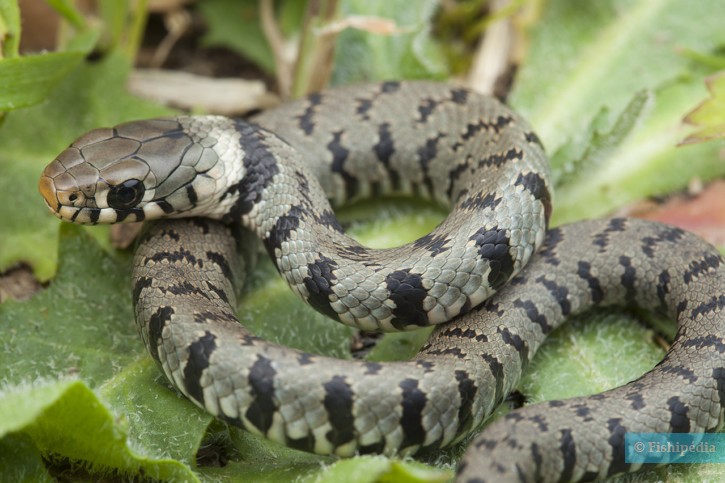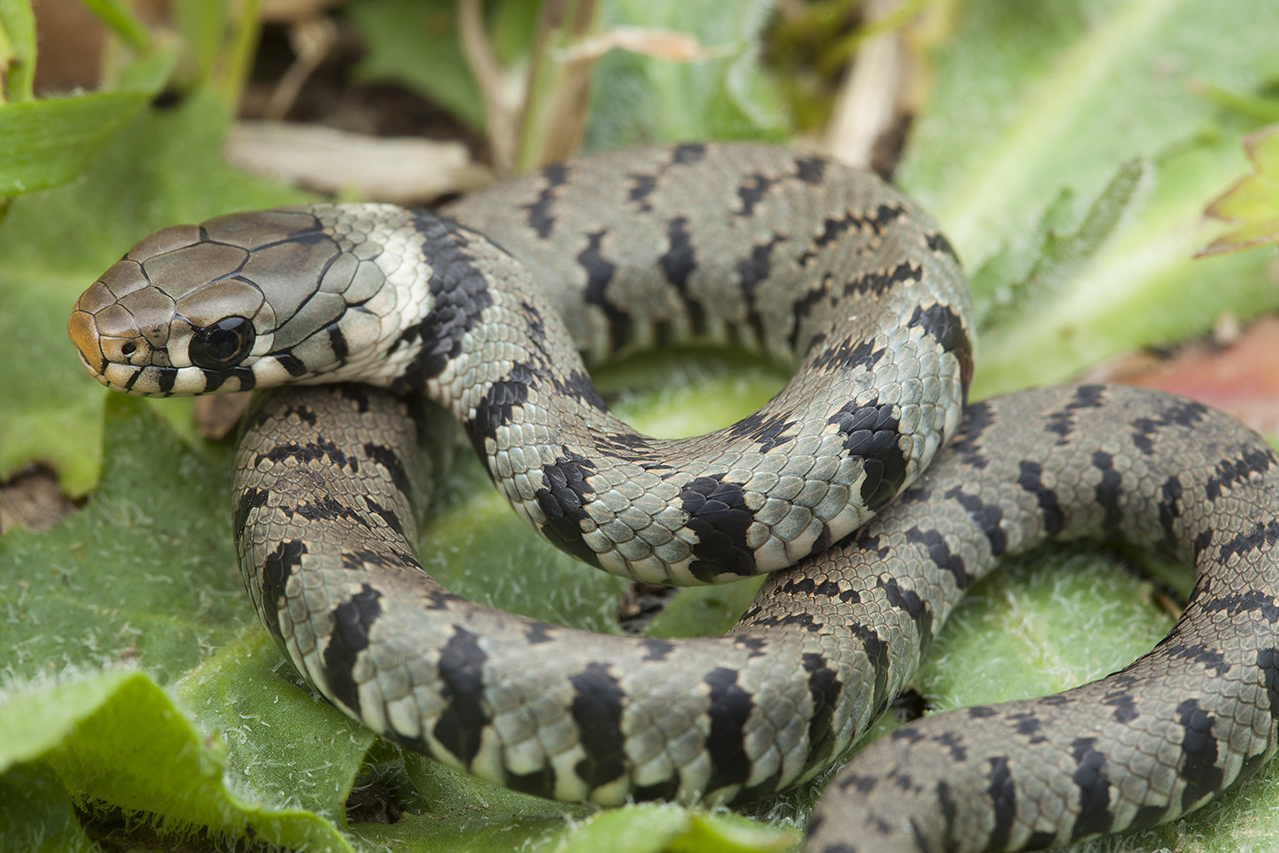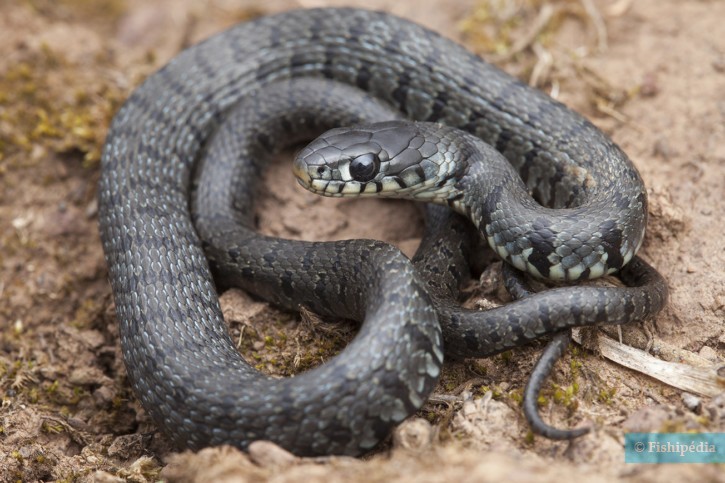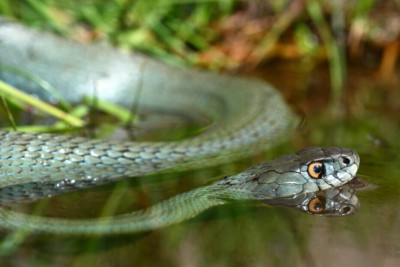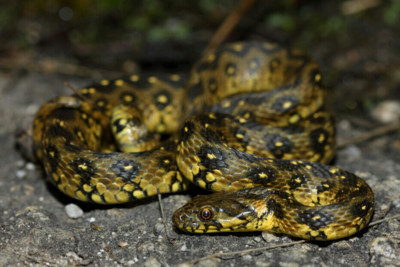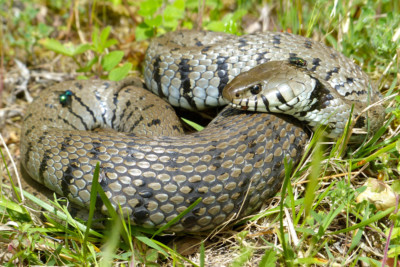Introduction
The grass snake Natrix natrix is the most widely distributed colubrid snake species in Europe. Following various reorganizations, several subspecies of the N. natrix have been raised to species level (N. helvetica, N. astreptophora). There are still a large number of subspecies with distinct patterns.
Accustomed to aquatic environments, it frequents marshy areas and wild riverbanks in a large part of Europe, including Scandinavian countries and Russia. It is also present in Central and Minor Asia. Once consumed by humans, it was long a discreet companion of farmers. In winter, it would hibernate in warm manure piles. It was consumed until the Middle Ages.
Today, although it is not considered threatened, its populations are becoming increasingly rare. The causes are the transformation of wetlands, agricultural pollution, and road traffic. Not to mention a disease from the United States that particularly affects Great Britain. Important population basins still exist in the Balkans, Italy, Turkey, and in most mountainous regions.
Who is it?
Morphology
-
Type
-
Female size120 - 150 cm
-
Male size65 - 85 cm
-
Motiftasks
-
Mimicryplants
-
Longevity25 year
-
Type
-
Female size120 - 150 cm
-
Male size65 - 85 cm
-
Motiftasks
-
Mimicryplants
-
Longevity25 year
How to recognize This reptile ?
Like its congeners, the body is brown to olive, sometimes gray. It is difficult to differentiate from N. helvetica with which it shares many morphological characteristics.
As its name indicates, it has a collar-like pattern around the neck. This is manifested by whitish to golden spots with a black band upstream that enhances the colors. It is more pronounced in young individuals and gradually fades with age. Contrary to N. helvetica, the collar spots are always a uniform color. They are two-colored in its close cousin.
The scales are keeled, with a prominent ridge in the center. Those on the head are wider, sometimes rectangular. There are seven upper labial scales.
Apart from its congeners, young N. natrix are sometimes confused with Aesculapian snakes (Zamenis longissimus) and green and yellow snakes (Hierophis viridiflavus). The neck pattern is similar, however, these two do not have keeled dorsal scales.
Sexual dimorphism
Females, larger than males, can reach up to 1.50 meters. According to some beliefs, individuals could reach two meters. These facts have never been corroborated by scientists. Males are slimmer and smaller, but their tails are proportionally longer. They also have more scales.
Behaviour & Life cycle
-
Sociabilitysolitary
-
Way of livingdiurnal
-
VenomousNo
-
Dietpredator
The grass snake is one of the most aquatic snakes in Europe. It usually frequents stagnant or slow-flowing waters in which it hunts its preferred prey: amphibians. An excellent swimmer, it sometimes shares its environment with other freshwater snakes, such as N. Tessellata. Intimacy between various populations does not generate aggressive behavior. Although it accepts its cousins, the snake is a solitary animal outside of reproduction.
Outside the water, it sunbathes on the riverbanks or in habitats at the forest edge. Due to its secretive nature and brief escapes, some of its biology is still under study. Long sunbathing sessions allow snakes to warm up and aid digestion.
Males and females feed on the same prey, but in different proportions. Females are more likely to target large toads and sometimes small mammals. Males focus on frogs and tadpoles. In mountainous areas, the grass snake also hunts newts and salamanders. During aquatic hunting sessions, this species uses its remarkable olfactory senses. It is also capable of detecting the waves emitted on the water's surface by amphibians as they croak.
Males are relatively sedentary. They mainly move during the breeding season, between May and June. Females move before and after egg-laying, which is explained by the search for a suitable birthing site. They bask in the sun to warm up or digest. At the slightest alert, they dive or seek refuge in vegetation.
Like its congeners, the grass snake can deploy an arsenal of tricks and deceptions to escape predators. If it cannot flee, it may attempt intimidation displays by mimicking other snakes. It can imitate vipers and cobras by flattening its head. This strategy particularly scares wary migratory birds of venomous snakes. In addition to this behavioral mimicry, it can hiss loudly or coil around the aggressor, secreting a repugnant whitish liquid from its cloacal glands.
The last, and not the least, defense is its ability to play dead. It flips onto its back, opens its mouth, tongue hanging out, and releases blood from its nose and mouth. It also regurgitates its foul-smelling liquid to indicate to the predator that it is inedible. At the slightest distraction from the predator, it quickly disappears into the vegetation or plunges into nearby waters.
As soon as the cold season begins, the grass snake seeks a shelter to hibernate. During this period of inactivity, it resides in holes, leaf piles, tree stumps, or even haystacks. It can also enter basements or cellars.
Reproduction
-
Reproductionovipare qui pond sur substrat caché
-
Clutch size10 - 50 eggs
As in other Natrix species, males and females mate in groups. The larger males have a better chance of fertilizing females during these long mating activities.
A few weeks after mating, the female lays around thirty eggs in a warm and humid shelter. For example, she may use rodent burrows or dried-up stream beds. At birth, the young are independent and must learn to hunt on their own. Measuring about twenty centimeters, they are preyed upon by many wading birds and mammals during the first few weeks.
Harmless species
The grass snake is typically timid. Intimidation displays occur only if it cannot escape. Bites are very rare and harmless.
Origin and distribution
Geographic distribution & Conservation
Although widely distributed, it is difficult to know its exact range after the announcement of new species in 2016 and 2017. It is probably present in England, Spain, Portugal, and northern Africa, but it could also be confused with the two new species, N. helvetica and N. astreptophora.
It is formally identified from the east of the Rhine to Minor Asia and Mongolia. Some populations may also live in northern China.
Conservation status of populations (IUCN)
What is its habitat?
Natural environment characteristics
-
Temperature14 - 30 °C
-
FlowMedium, Slow and Stagnant
Biotope presentation
The grass snake is devoted to aquatic environments. It frequents a wide range of habitats, provided they are in good conservation status. Populations are higher in marshy areas, near ponds, lakes, and wild rivers. It is also observed in forest ponds and streams.
To go further
Sources & Contributions
Participation & Validation
The Fishipedia team and specialist contributors are committed to providing high-quality content. However, although the information comes from scientific sources or testimonials from specialists, the cards may contain inaccuracies.
Translation
Translation done with the valuable contribution of our translators, who make this information available to a wider audience. We sincerely thank them for their commitment.
Bibliographic references
- - GBIF
- - Distribution and hybridisation of barred and common grass snakes (Natrix helvetica, N. natrix) in BadenWürttemberg, South-western Germany - Nadine Schultze - Hubert Laufer - Carolin Kindler - Uwe Fritz - Herpetozoa - 2019.
- - Evolution and phylogeny of the genus Natrix (Serpentes: Colubridae) - D. GUICKING - R. LAWSON - U. JOGER - M. WINK - Biological Journal of the Linnean Society - 2006.
- - The contact zone of the grass snake (Natrix natrix) in Switzerland - Maxime Chèvre - Université de Neuchâtel - 2015.
- - The Fifth Labour of Heracles: Cleaning the Linnean stable of names for grass snakes (Natrix astreptophora, N. helvetica, N. natrix sensu stricto) - Uwe Fritz - Josef Friedrich Schmidtler - Vertebrate Zoology - 2020.
Scientific partners
Tags
Same genus
